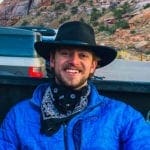|
Getting your Trinity Audio player ready...
|
Established in 1994
Death Valley is the most extreme of its kind: the hottest, driest and lowest place in the west. But this description doesn’t do justice to the geologic splendor, diverse landscapes, and peaceful stillness it has to offer.
Overview
In a way, the name says it all. Death Valley is one of the harshest, most inhospitable places in the United States. It’s the largest National Park outside of Alaska, which includes a large portion of the Mojave Desert.
But in another way, Death Valley is very much alive. It is home to some of the most vibrant landscapes on Earth. Death Valley is a land where sand moves like waves on the ocean, where stones wander aimlessly over the desert, and where the Milky Way lights up the night sky.
Enchanted yet? We’re just getting started. In this guide, we’ll lay out all the reasons to love Death Valley, when and how to visit it, and what to see while you’re there.
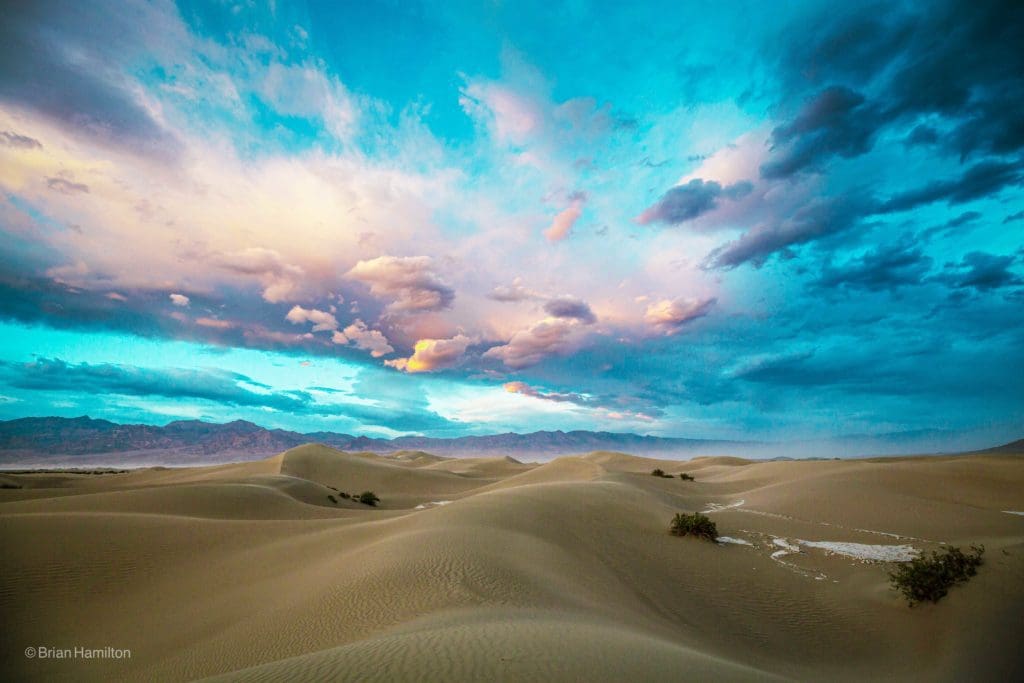
Sand dunes in Death Valley National Park, California.
Table of Contents:
Article Navigation: Click on any of the listed items in the table of contents below to jump to that section of the article. Similarly, clicking on any large, white section header will jump you back to the Table of Contents.
- Overview
- Human History
- Ecology
- Geology
- Where To Stay
- Enjoying The Park
- Conclusion – A Living Landscape
Human History
Believe it or not, there is life in the desert – even human life. Death Valley has had people living in it for the last 10,000 years. That’s about as long as there have been humans in North America.
Archaeologists have identified as many as four distinct human cultures that lived in Death Valley before colonists arrived. Each of them left behind mysterious relics of life, like petroglyphs and stone constructions.
The prehistoric Nevares Spring People, Mesquite Flat People, and Saratoga Spring People each spent a few thousand years in the region. But when white settlers arrived, the Timbisha Tribe were Death Valley’s only inhabitants. The Timbisha people lived near scant water sources, and lived surprisingly well in such desolate conditions.
The first white settlers traveled through the area during the California Gold Rush. These first wagon trains entered Death Valley expecting a shortcut for the Old Spanish Trail. They stayed just long enough to almost perish in the fiery sun. As one of the women escaped with her life on foot, she turned and said “Goodbye, Death Valley.” And so the area was named.
In the following decades, white settlers discovered that mineral deposits were rich in Death Valley. In the late 1800s, several companies were mining evaporates like borax and talc in the valley, which were shipped out by rail. By the 1920s, Death Valley was the largest hotspot for borax mining in the world.
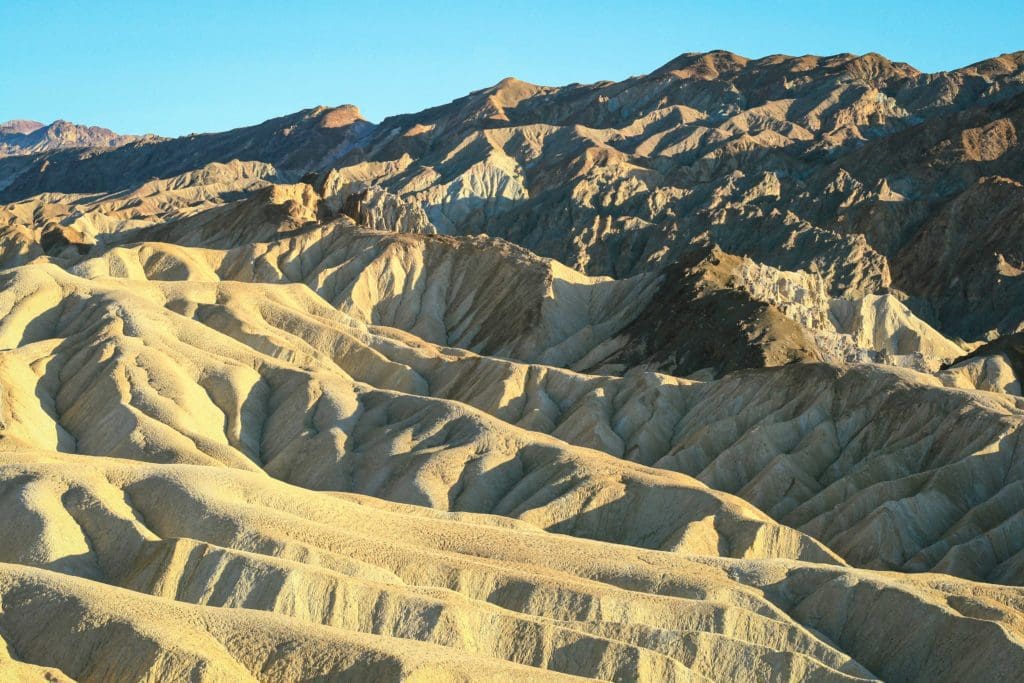
Zabriskie Point in Death Valley, California.
Other miners struck gold in Death Valley, quite literally. Veins of precious metals were discovered in the rugged hills, but the difficulty of working in the desert climate made most deposits unprofitable.
After World War I, tourists began to poke around the shockingly harsh landscape of Death Valley. Some of the mining companies converted facilities into lodging and diverted sparse waterways. The destination became popular in the off-season. Private resorts opened, like Scotty’s Castle.
The creation of Death Valley National Monument in 1933 secured the land for future generations. But mining didn’t stop. In fact, new technologies like strip mining and open pit mining only increased the impact that claims had on the landscape. It wasn’t until 1976 that congress passed an act to allow the National Park Service to oust miners if they found their operations were too harmful.
In 1994, the monument was upgraded to a National Park. Tourists continued to stream in to see the strange wonders of the deep desert. The borders of the park were expanded most recently in 2019, when an additional 35,000 acres were added. Today, the park sees over a million visitors per year.
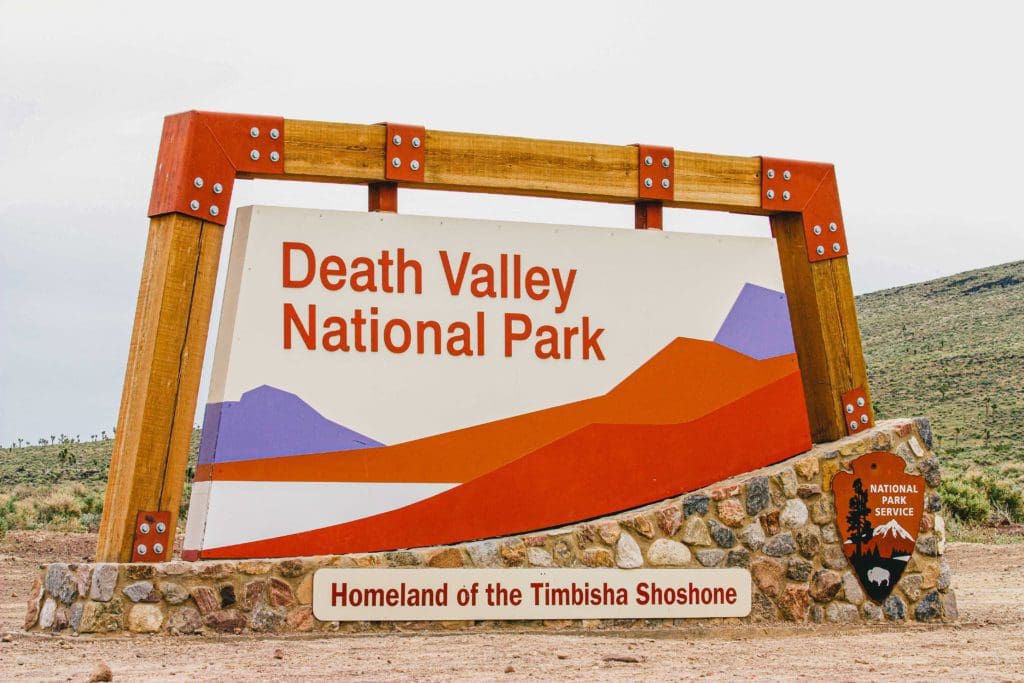
Entrance of Death Valley National Park.
The Mojave Ecosystem
The Mojave Desert, much of which is contained in Death Valley, is not just a hot desert. It’s one of the hottest places on earth. In July, temperatures skyrocket into the 120s and even 130s. And as climate change continues to exaggerate high highs, hot and dry is likely to get hotter and dryer.
In fact, the hottest temperature ever recorded on earth was measured in Badwater Basin, a staggering 136°F (50°C). So it goes without saying that anything that lives in Death Valley is, at the very least, robust.
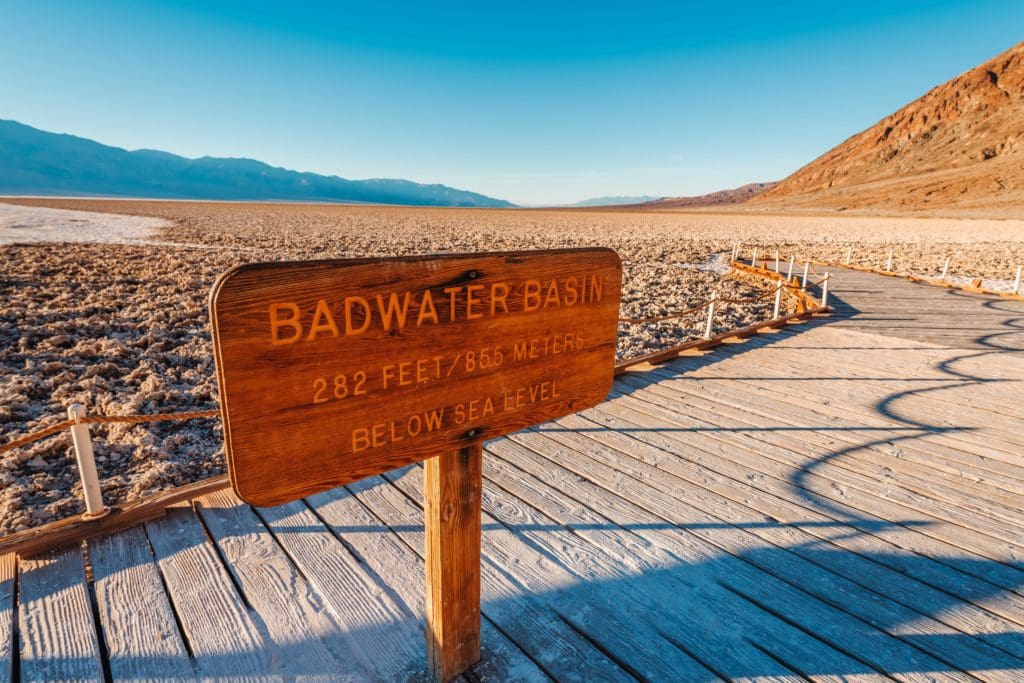
Badwater Basin at sunset.
And despite how the name makes it seem, there are a surprising amount of living things soaring, crawling, and even swimming around Death Valley National Park. Oddly, the park is home to a huge variety of critters. Everything from desert tortoises to bighorn sheep, from highly-evolved cave fish to frogs and salamanders can be found here.
Part of this variety is due to the park’s relief. The extreme changes in elevation create different conditions, which allow different plant communities to thrive. In the basin bottoms, where it’s hottest and sunniest, sparse scrub and cacti are the only plants that can hack it.
But higher up, things start to change. Joshua trees and pinyon pines start to appear. Higher still, the ancient bristlecone pine and limber pine dot the rocky sides of mountains. All in all, over 1,000 plant species have been recorded in the park.
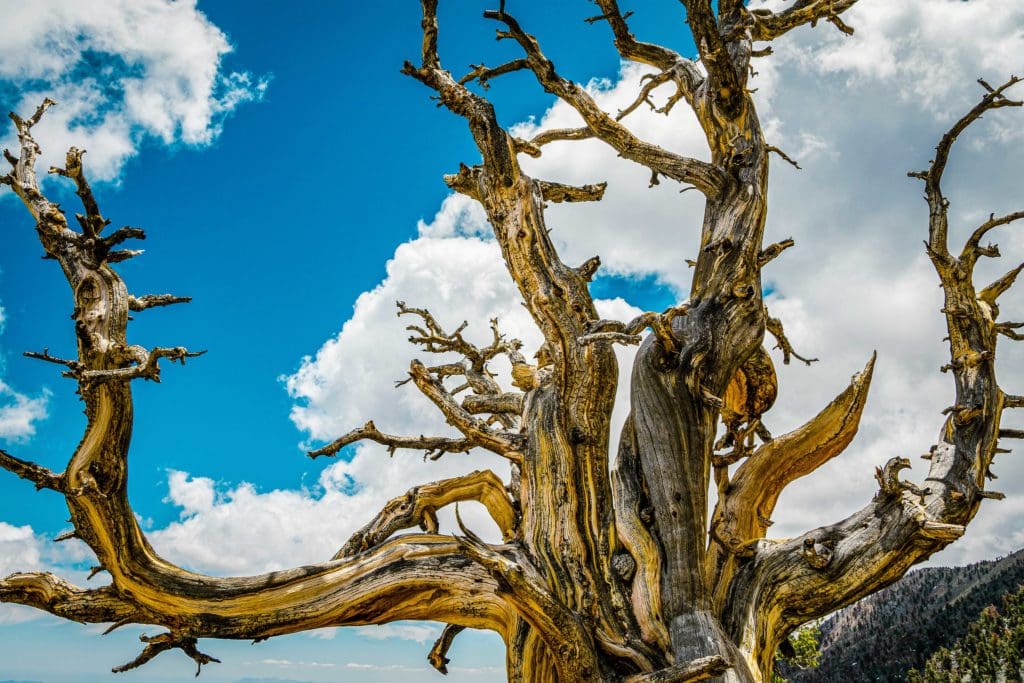
Dead Bristlecone pine (Pinus longaeva) in Death Valley National Park, California.
So to say that the Mojave Desert is completely uninhabitable is just false. But the animals that live here are rugged, and have to fight to survive. The loggerhead shrike, for example, is a songbird that has adapted to hunt small reptiles, impaling them to dry on cactus spines before eating them.
Other charismatic wildlife include the roadrunner, desert iguana, Mojave desert sidewinder, coyote, and ringtail (a strange-looking desert cousin of the raccoon).
Even mountain-dwelling animals like porcupines, bobcats, and western toads can be found here. But possibly the most famous animal in Death Valley is the humble pupfish. These fish may be unassuming looking. But four of the five species found in Death Valley are found nowhere else on earth. The Devil’s Hole Pupfish in particular is found in only one underground lake.
The rarity of these species has made them the focus of conservation efforts over the years. And every year, diligent efforts are made to make sure their populations are intact. More than most threatened species, endemic species are a fragile piece of the earth’s biodiversity life support system.
Extreme places, like Death Valley, or the North Pole, are hubs of endemic species. When we damage ecosystems that harbor these pockets of biodiversity, we lose important genetic diversity that sustains life in general on earth.
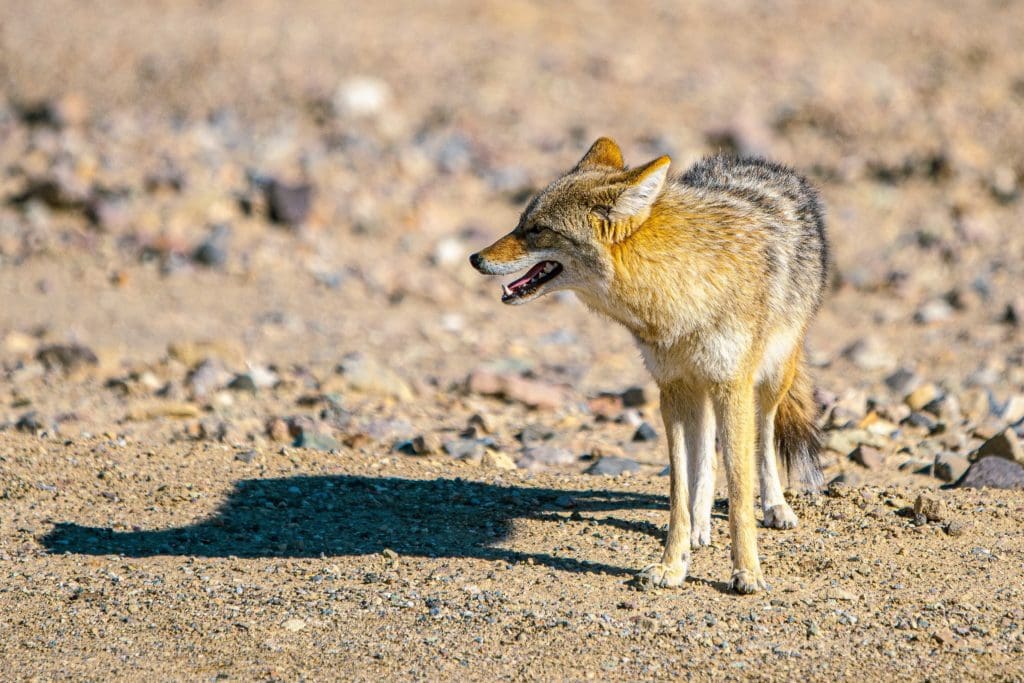
Desert Coyote in Death Valley National Park
Best Times to Visit Death Valley National Park
Enjoying your visit to Death Valley is all about timing. Many people taking summer vacations head to Death Valley in June, July, or August, only to find searing sun.
Seasoned desert dwellers know better. The best time of the year to visit the hottest spot on the globe is in the dead of winter, when temperatures are mild and comfortable.
Typically, December through March will have highs in the 60s to 80s, with lows in the 40s to 60s. The days may be a little shorter, but that’s not necessarily a bad thing.
The other strategy for beating the desert heat is to see it under the stars. At night, the vast, rocky landscapes of Death Valley take on a different character.
On a clear night with a full moon, you’ll notice that there is enough light to walk by. And on a moonless night, the stars are unlike anywhere else. Death Valley is famous for its clear weather and dark skies, which make for optimal stargazing conditions.
It’s one of the best places in the country to practice amateur astronomy, night photography, light painting, or to just stand in awe of the majesty of the night sky.
Events in Death Valley National Park
In general, midwinter is the best time to visit Death Valley. But if you have the opportunity to catch any of these special events in Death Valley, you should take it.
Death Valley Dark Sky Festival
Each Spring, a festival celebrating the wonders of astronomy takes place in Death Valley. The festival is a collaboration between the Death Valley Natural History Association, NASA, SETI, and CalTech.
This event features talks by space experts, astrophotography meetups, and telescope viewings. It’s an amazing coordination between a lot of very cool organizations with the ultimate goal of spreading the love of science.
Everyone’s looked at the night sky, but few people get to appreciate it like this. If you’re planning a trip in the Spring, don’t miss out.
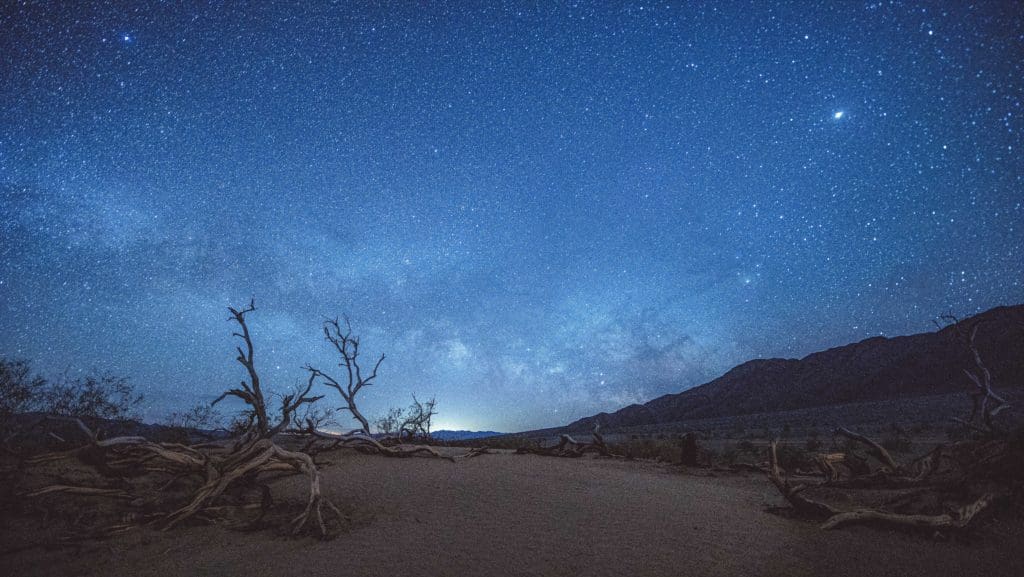
Milky Way from Death Valley.
Audubon Christmas Bird Count
The Christmas Bird Count is Audubon’s global citizen science event. Just about anywhere you can think of, birders are pitching in to increase our understanding of how bird species use landscapes.
Naturally, Death Valley is a perfect place to go birding. The clear skies and wide open spaces make for pristine birdwatching conditions, and the park sits along major migratory routes.
If you’re thinking about getting away for Christmas, consider joining the droves of bird nuts that flock to Death Valley every year. Bring your binoculars and prepare to learn a ton about ornithology.
Death Valley Wildflower Superbloom
Death Valley is a living gallery of natural wonders. But nothing is bigger and more awe-inspiring than a wildflower superbloom.
When conditions in the park are just right, seed banks in Death Valley’s soil are spontaneously switched on. Wildflowers pop up out of the ground by the millions, carpeting the entire valley in color.
The start contrast that comes over this “barren” landscape when it’s full of flowers is unbelievable. Whenever a superbloom happens, Death Valley becomes the most beautiful place in the world.
But – superblooms are not a yearly event. They take place only when the environmental conditions are perfect. We can predict when they might happen to some extent, but not precisely.
So keep your ears open. Check to see if this year could be another big one. And if you hear that a superbloom is going to happen, high-tail it to Death Valley. You can’t miss it.
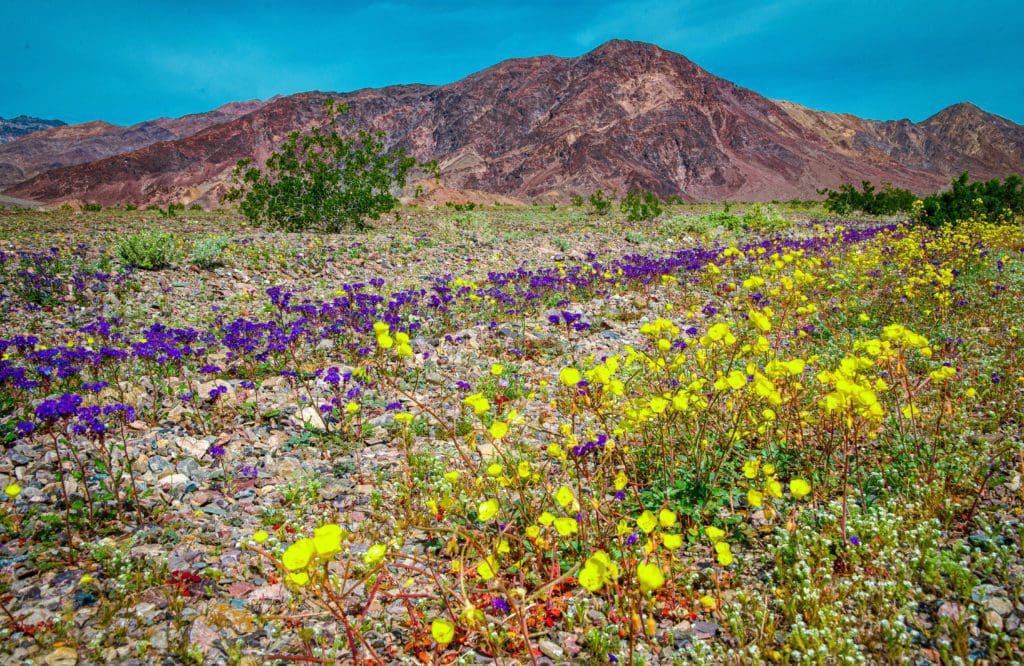
Feld of yellow and purple wildflowers in Death Valley National Park.
Basin and Range Geology
It’s easy to see Death Valley as part of the larger basin and range province. The characteristic far-off mountain ranges, separated by broad, flat valleys are characteristic of the entire Great Basin.
This entire area was once the ocean floor. Long ago, the coastline reached to the Rocky Mountains, and Death Valley was under water. As sea level receded, and the ranges of Nevada, California, and Utah surfaced, the tectonic plate sitting underneath them stretched.
The earth, pulled like taffy, spread thin. The mountain ranges slowly grew further apart, and the basins between them grew deeper. The ocean receded further, depositing salt in flat plains, or salt flats. This slow process of stretching is what caused the incredible relief of Death Valley.
Badwater Basin, the lowest point in North America (at 282 feet below sea level), sits just 16 miles from Telescope Peak (11,049 feet). The vast difference from basins and ranges in and around the park is what creates a lot of the ecological niches we see in Death Valley.
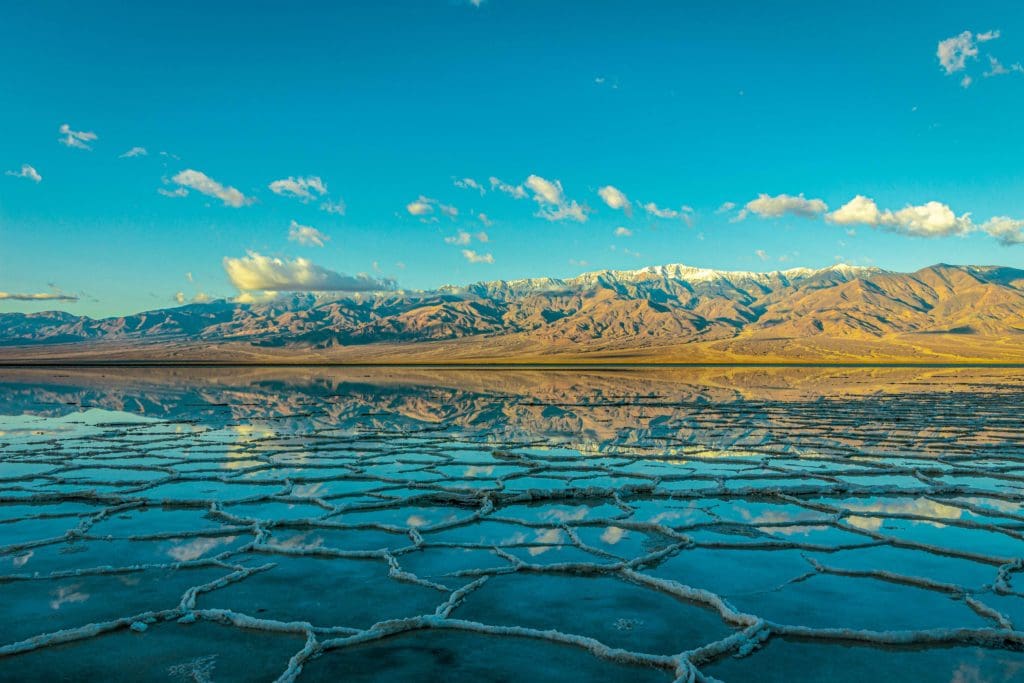
Badwater Basin and Telescope Peak in Death Valley National Park.
But the dry lake beds are not the only story here. There is also extensive evidence of volcanism in the park. There are at least four volcanic formations in the park, some of which are ancient. Others, like Ubehebe Crater, are very young.
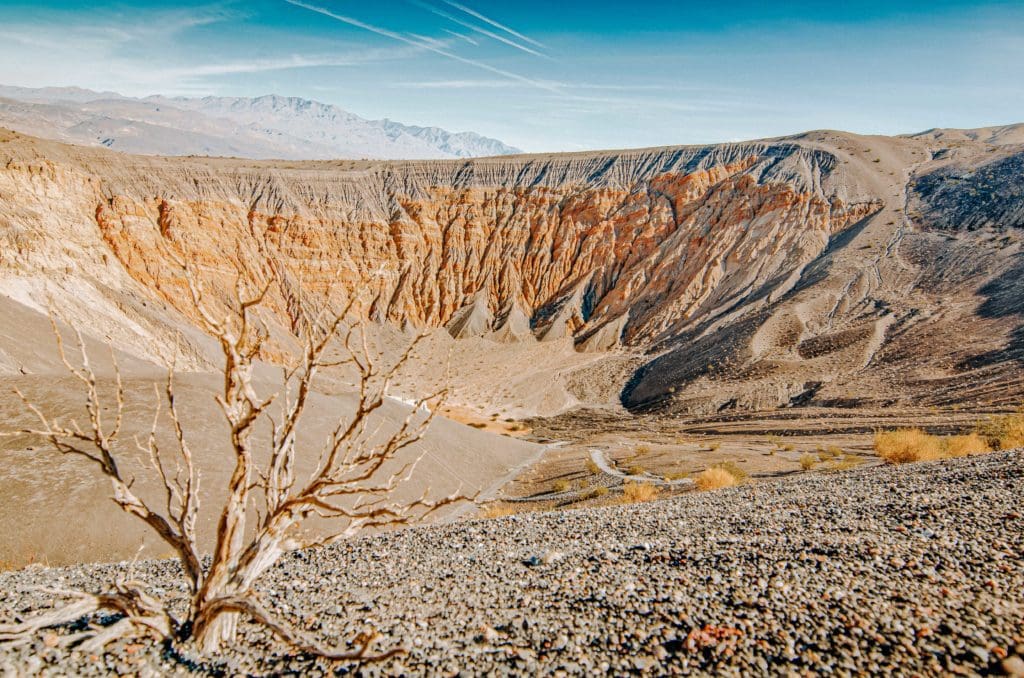
Low angle view down the side of the Ubehebe Crater of Death Valley, California.
Periods of intense weathering and sedimentation, and intense volcanic events have given rise to a vast array of minerals in the park. There are box canyons made of marble, petrified lava flows, and a whole rainbow for carbonates which form a spectrum of colors and shapes across Death Valley.
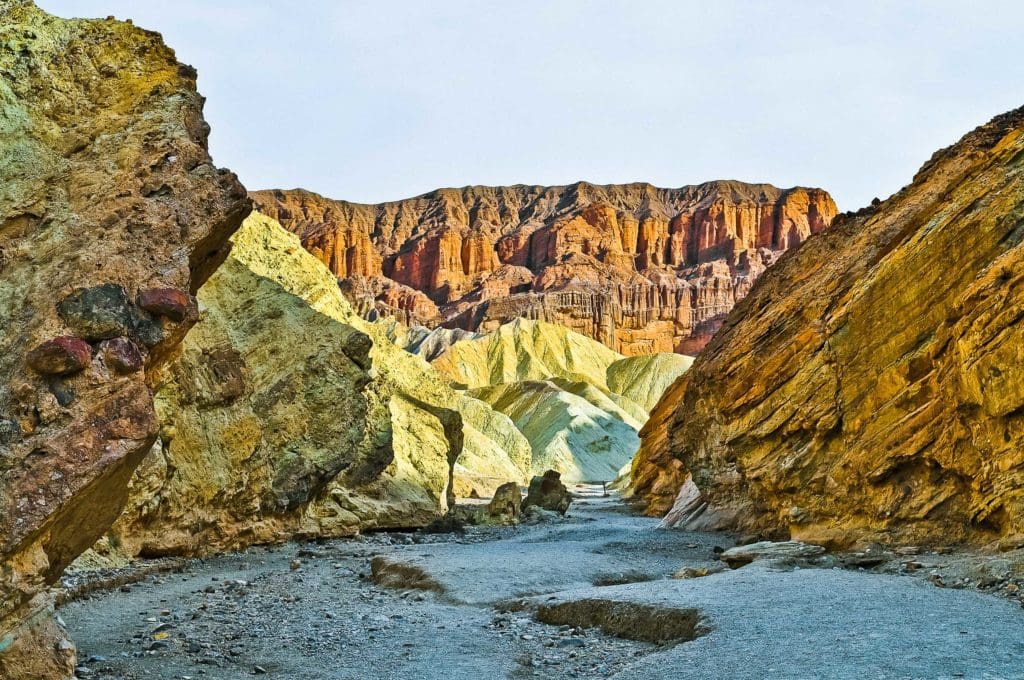
Hiking trail through Golden Canyon in Death Valley.
Where to Stay
Hotels and Resorts
Interested in the top accommodations within Death Valley National Park? Look no further, as we have insider knowledge on the most popular and comfortable places to relax after a day of adventuring through the otherworldly landscapes of this amazing park.
Looking for a luxurious stay in the heart of Death Valley? Look no further than The Inn at Death Valley, with its stunning mission-style architecture and top-notch amenities. Immerse yourself in fine dining, relax by the outdoor pool fed by a natural hot spring, indulge in spa treatments, and stroll through the beautiful palm gardens. As the only 4 Diamond resort in Death Valley, you can be sure that this is the epitome of luxury.
For those seeking a more affordable adventure, the Best Western Pahrump Oasis could be the perfect choice. With rates beginning at $89 per night, you’ll have extra funds to use for discovering all that the park has to offer. Take in the stunning vistas of the Sierra Nevada Mountains from the heated pool and spacious sun deck, which make for an ideal spot to unwind after a day of exploring or hiking.
If you are someone who enjoys a touch of luxury while camping, consider staying at Tarantula Ranch Vineyard, which is only 37 miles away from the park. It offers a one-of-a-kind and cozy experience for those who want to be immersed in nature without sacrificing too many comforts.
If you’re traveling from the east, Beatty, Nevada is where you’ll enter Death Valley. As the “Gateway to Death Valley,” Beatty sits just 7 miles from the entrance of the park and boasts a quaint small-town atmosphere that’s difficult to resist.
Camping
Because of its size and remoteness, most visitors come to Death Valley for camping trips. And because half of the experience of seeing the park doesn’t happen until the stars come out, it only makes sense to spend the night.
Here are some of the best campgrounds in the park.
Furnace Creek: Furnace Creek Campground is in one of the best locations to see the major sights and sounds of Death Valley. Located at the north end of Badwater Basin, you’ll have prime access to Dante’s View, Zabriskie Point, Artists Drive, and services at Stovepipe Wells Village.
There are 136 sites at Furnace Creek. But if it’s too crowded, you can always retreat to Sunset or Texas Spring Campgrounds. These are both developed areas located right around the corner.
Mesquite Spring: Mesquite Spring Campground is an ideal access point for the sights in the northern reaches of the park. It puts you near Scotty’s Castle, Ubehebe Crater, Racetrack Playa, and Eureka Sand Dunes. If it’s not your first rodeo in Death Valley, or if you want to get a little further from crowds, this is a great place to be.
Wildrose: If you’re approaching from the western side of the park, Wildrose Campground is an ideal spot to pitch your tent. It provides good access to lots of 4×4 adventures, including Telescope Peak. It’s also close to Eureka Mine, Nemo Canyon, and the historic Skidoo ghost town.
To go a little more rugged, you can opt to stay at Thorndike or Mahogany Flat Campgrounds in the same area. These spots provide interesting views of Badwater Basin from the west.
Enjoying the Park
The more you research Death Valley, the more things you’ll find to do. But if you’re on a limited timeline and need to pick a few things to see, which are worth your time? These are the top destinations inside the park.
Badwater Basin
Badwater Basin, well-known for its absurdly hot summers, sits at 282 feet below sea level. It’s the lowest, hottest point in the US. Once upon a time, it was the seafloor. Since then, the water has dried up, leaving a broad salt flat.
It’s hard to explain what’s so incredible about it if you haven’t seen it for yourself. Maybe it’s the vastness of it. Maybe it’s the number of strange phenomena nearby. Suffice it to say that Badwater Basin has a magical aura, and it’s something you shouldn’t miss.
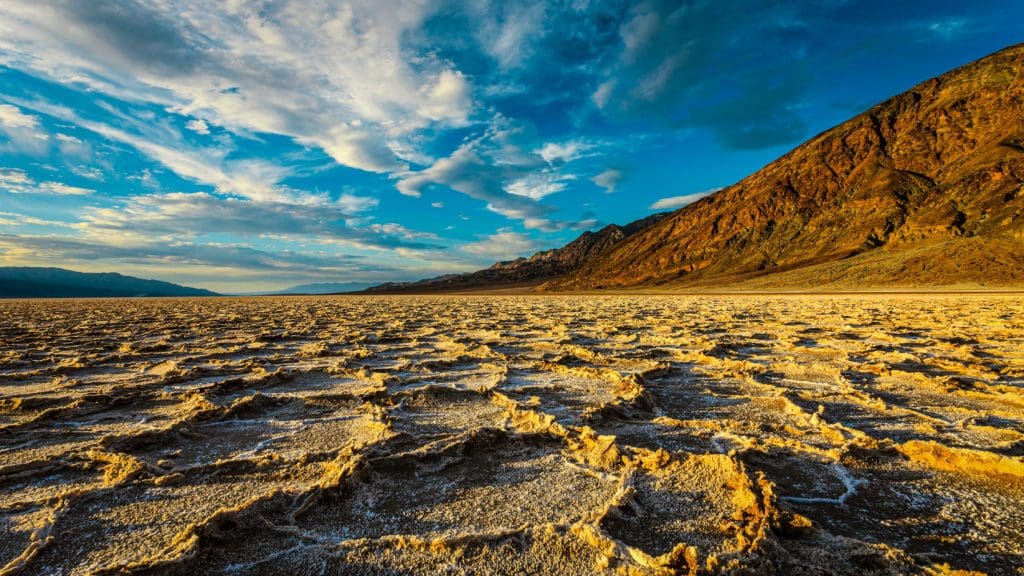
Amazing landscape at Badwater Basin in Death Valley National Park, California.
Racetrack Playa
The Racetrack Playa holds one of Death Valley’s great mysteries. It’s a broad, flat pan, covered in sand and dust and large stones. But after years of observation, visitors realized that the stones were slowly sliding over the surface of the playa.
This phenomena has been studied and pondered over by everyone from visitors to geologists. Why does it happen? The jury is still out. The wandering stones move, as if by some magical unseen force, crawling over the dry pan under the Milky Way.
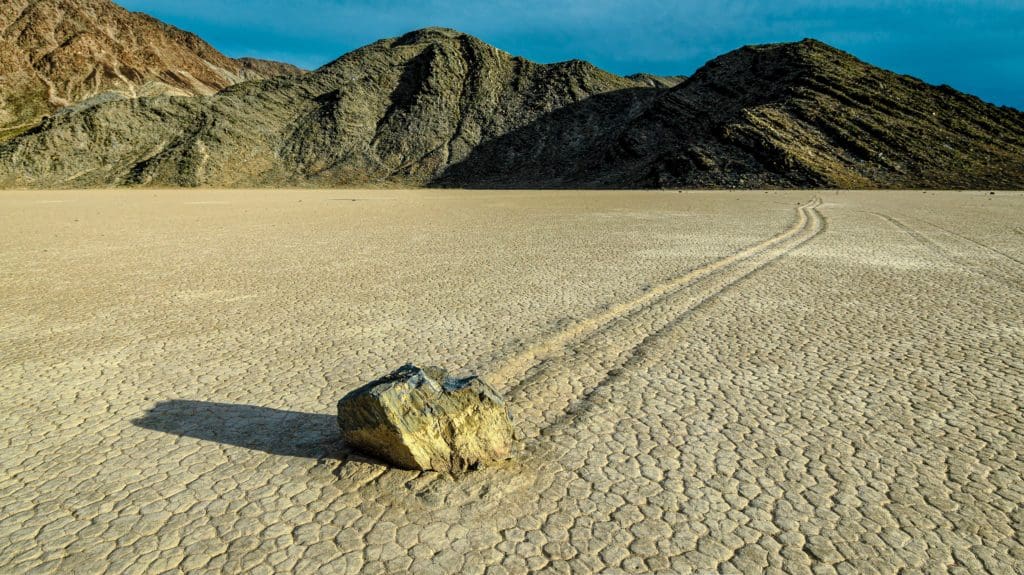
Sliding stones on a dry lakebed at Racetrack Playa.
Sand Dunes
There are several expanses of dunes in Death Valley. Their shapes are mesmerizing, especially set against the background of the foreboding mountains.
The two most popular sand dunes to visit are Mesquite Flat and Eureka Dunes. Both are fairly easy to get to from the highway and are well worth your time. At these sandy oceans, you can watch as the wind shapes the landscape. Trust us, the desert is alive.
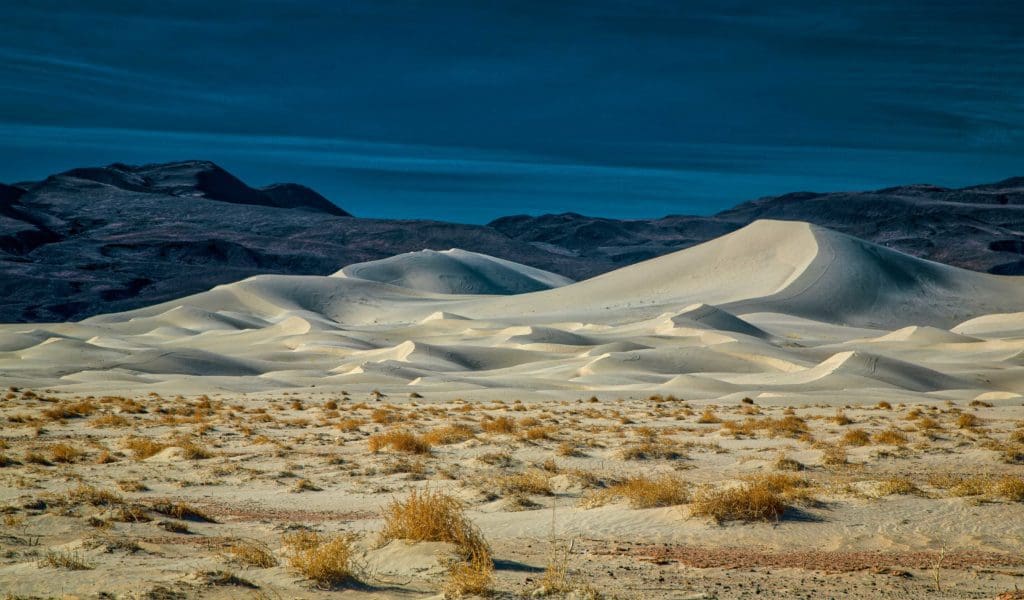
Ripples, curves, swirls and waves are numerous at Eureka Dunes at Death Valley National Park.
Stargazing
No trip to Death Valley would be complete without taking some time to gawk at the sky. Death Valley National Park is one of the darkest skies in the US, completely free from light pollution. Plus, there are hardly ever clouds to cover the stars.
The best part about stargazing is that you can do it from anywhere for free. It takes no energy or special gear. Just a sense of wonder and some patience. Many backyard astronomers tote their telescopes to the park to target the moon’s craters, neighboring planets, and other phenomena.
Some of the best times to stargaze in the park are during meteor showers, like the Leonid (mid-August) or Perseid (mid-December). There is truly nothing quite like watching thousands of shooting stars around a campfire. Other events like lunar eclipses, passing comets, and planetary alignments are a surefire way to have your mind blown.
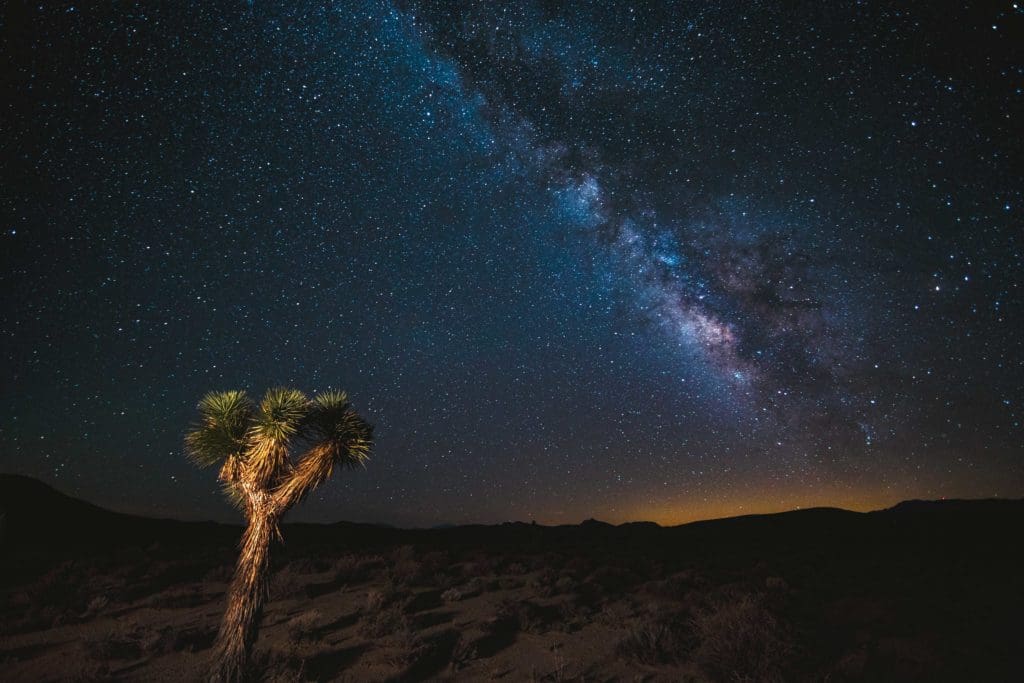
Death Valley at night under the Milky Way
Drive-up Sights
Because of Death Valley’s intense heat and immense size, auto tourism has been the best way to tour the park since it became a park. Visitors see most of the park’s sights from the cozy, air-conditioned interior of their cars.
Luckily, the park has a great road system with lots of access for motor traffic. Here are the best things you can see in the park from the comfort of your vehicle.
Zabriskie Point
Zabriskie Point is just as beautiful as it is fun to say. It’s one of the most photogenic views in Death Valley, showcasing the drastic elevation gradient from valley floor to mountain summit.
Just a quarter of an hour from Highway 190, Zabriskie Point is a good view to tack on to your day if you’re checking out the Badwater Basin/Furnace Creek area.
The Point sits atop a dusty badland overlooking Furnace Creek, and Telescope Peak. If you catch it at the right time, you may even be able to see Telescope Peak frosted with snow.
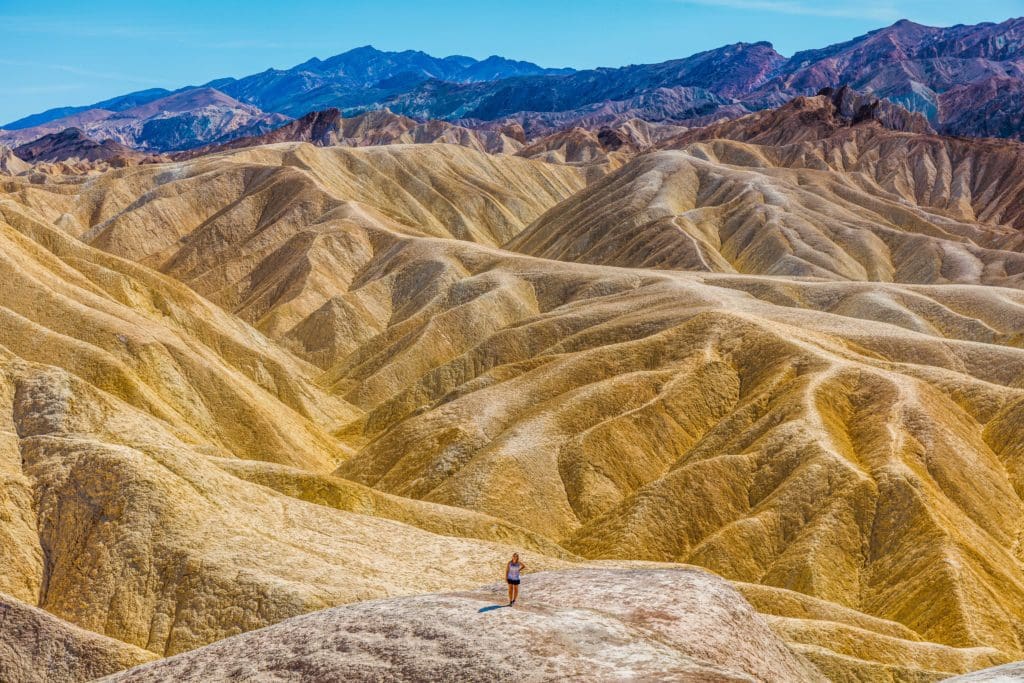
Beautiful view of the erosional landscape of hills composed of sediments from Furnace Creek Lake, which dried up 5 million years ago, at Zabriskie Point.
Dante’s View
Another spectacular vista in the Badwater Basin area, Dante’s View could make a grown man cry. The stark, rugged overlook peers down on Badwater Basin from atop the Black Mountains.
The contrast of the sharp-looking peaks jutting out of the flat, smooth pan is almost surreal. This spot draws photographers (who snap shots of the landscape and the night sky), stargazers, and bird watchers alike.
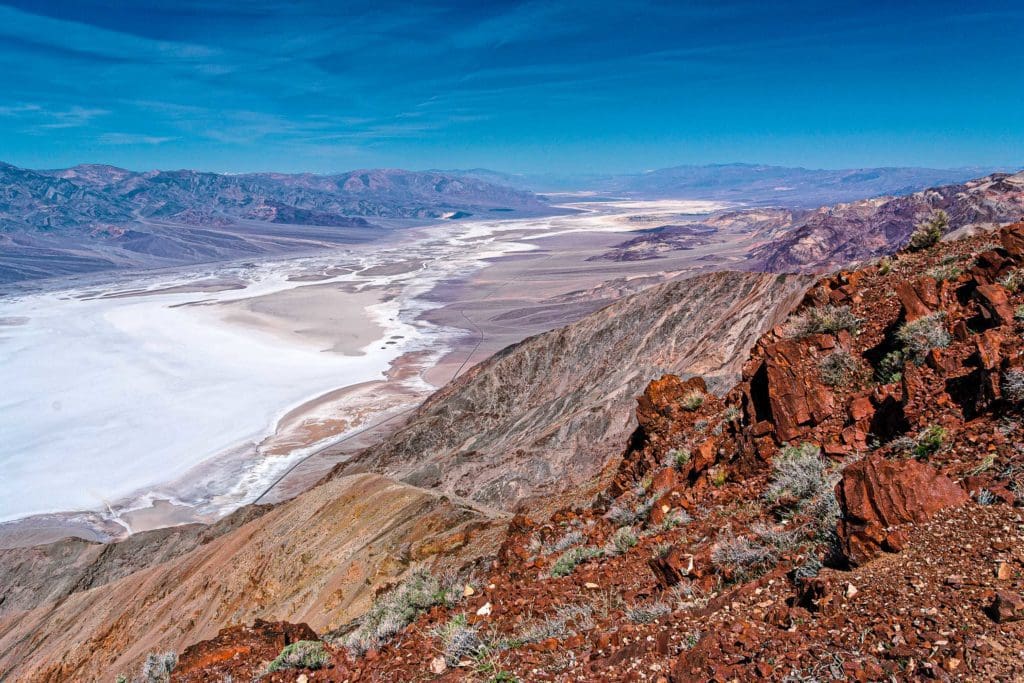
Scenic vista of Death Valley from Dante’s View
Devil’s Golf Course
One of Death Valley’s most alien landscapes, the Devil’s Golf Course looks like something out of a dream. In reality, it’s an ancient salt flat that eroded to create sharp pinnacles. It stretches on in all directions, like a surrealist painting. Standing on the Devil’s Golf Course, you can see firsthand the awesome power of nature.
Artists Drive and Artists Palette
Until you’re in it, the Artists Drive doesn’t seem like anything to write home about. From a distance, it looks like a yellow dirt hill. But the aptly-named Artists Palette opens up into a whole spectrum of colors, winding together across a maze of hills.
From one point, you can see every color of earth that makes up Death Valley in one place. It’s like a painting on a massive scale.
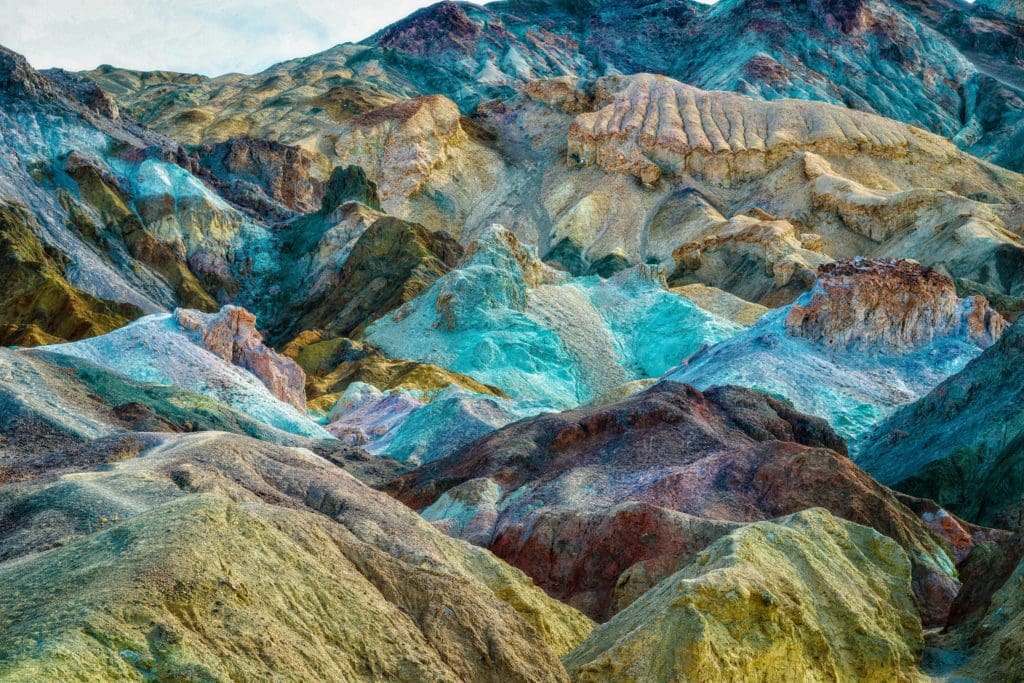
Colorful views from Artist’s Drive in Death Valley National Park.
Hiking
There are more trails in Death Valley than you can shake a stick at. Most are easy to moderate, a few are hard. The hardest part of any of them is the heat. Wherever you go, be sure to prepare sufficiently, bring more water than you need, and be sun smart. Here are a few winning trails to get you going.
Easy Walk-Ups
Many of the drive-up sights in the park take a little walking to get to. The Badwater Basin Salt Flats, Zabriskie Point, Artists Palette, and Harmony Borax Works all take a little footwork to access.
Normally, the kind of distances involved wouldn’t even be worth mentioning. But when the sun is beating down on you, even trivial hiking can be tough. Just be sure you’re prepared and take it in stride. It’s all part of the adventure of visiting such a harsh landscape.
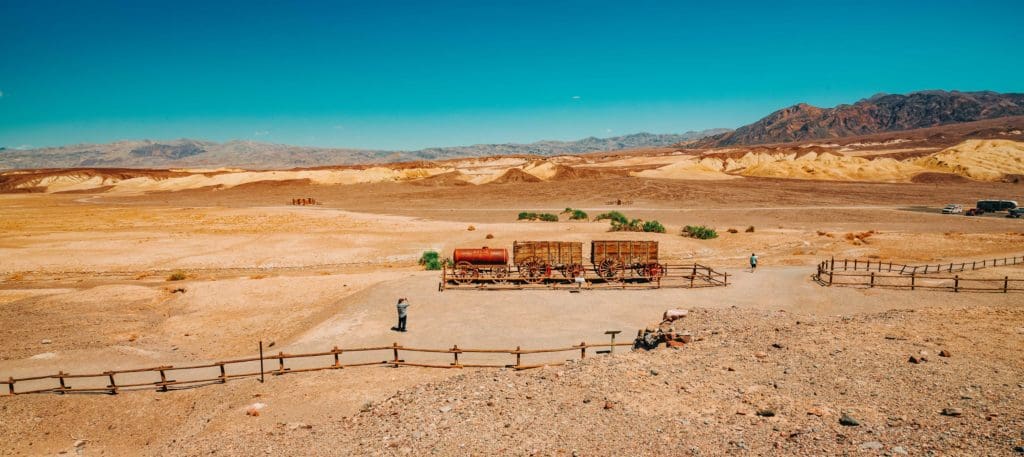
Harmony Borax Works, Death Valley.
Golden Canyon Loops: Golden Canyon is a vibrant, sprawling area with several five star trails to explore. This variant covers 6.4 miles, passing under the Red Cathedral and through a dense badland before looping back to the trailhead. This is a standout trail with medium distance and just enough elevation to get your heart pumping, and not one to miss.
Mosaic Canyon: Mosaic Canyon is another gold-standard moderate difficulty adventure in the Stovepipe Wells neighborhood. It winds and wiggles through 3-ish miles of spectacular rocky canyon. It’s just enough distance and gain to be challenging, without turning into a slog. Another must-see.
Telescope Peak Backpack: So you’re a high points fan, and you want to do some serious hiking. Alright, we hear you. What about taking on the tallest peak in Death Valley National Park? Telescope Peak is visible from colossal distances in the park. It’s so tall that it can sometimes be seen towering above the scorching valley bottoms, covered in snow.
This trail covers 40 miles and ascends nearly 12,000 feet of elevation in total. It’s a true desert adventure, requiring lots of prep and endurance. But if you fancy yourself an expert backpacker, you can’t find a better journey in Death Valley.

Panoramic view from the summit of Telescope Peak.
Mount Perry Day Hike: What if you’re a high point-addicted, hardcore hiker, but you just don’t have several days to take on Telescope Peak? Check out Mount Perry.
It’s a slightly less demanding, but still very adventurous romp to the top of one of the park’s most picturesque peaks. You’ll ascend roughly 2,000 feet to the summit, which anyone can tell you is no joke in the blazing sun.
Gravel and Mountain Biking
Here’s another tactic for beating the desert heat: go fast. Biking around Death Valley’s trails is a spectacular way to take in the country. And speeding over the rocky terrain is a surefire way to cool off.
Beginners will have a blast on Salt Creek Road, a mile-point-two blast over graded dirt that’s easily accessible from Furnace Creek.
Intermediates have a lot of options near Highway 190. The Skidoo Road, Hole-in-the-Wall Road, and Aguereberry Point Road all range from four to seven miles of gravel and rock. You’ll get to experience some of the park’s best sights, and you probably won’t see much traffic on the way.
Expert riders have the largest spread to choose from in Death Valley. Because of how many 4×4 trails there are around the park, there is some serious trail riding to be done in the hills. But beware, most of these spots are remote. Be prepared to get yourself out as far as you get in.
That said, if you feel like getting way off the grid, then be sure to check out Titus Canyon, Greenwater Valley, and Cottonwood Canyon. Distances range between 18 and 30 miles, and road surfaces vary wildly.
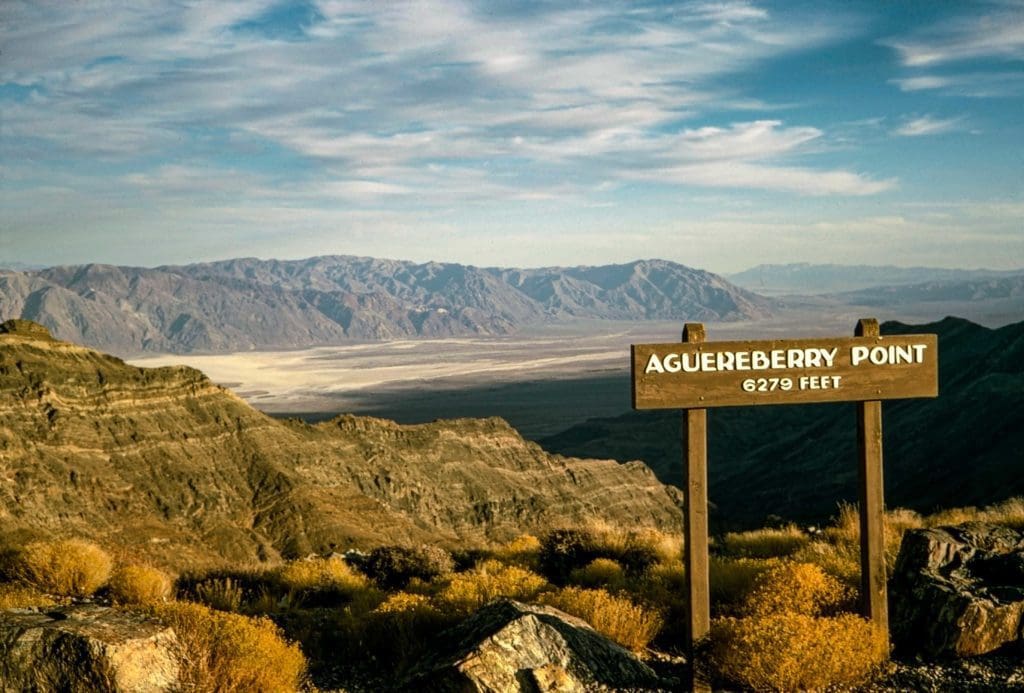
Aguereberry Point
4×4 and Off roading
There are a lot of things to see in Death Valley. Lots of them can be accessed by highway. Some of them require hiking.
But there is a whole world beyond paved roads and hiking trails in the park that is off limits unless you have a 4WD vehicle. And to be clear, we’re not just talking about dirt roads, or even high clearance roads.
There are hundreds of miles of backcountry roads in Death Valley National Park that require 4WD, a short wheelbase, and the skill to use it.
There are a ton of technical 4×4 trails in the park – ranging from washed out ruts to deep sand to full-blown rock crawling. Tall ledges, tight switchbacks, and big exposure are the regular fare here.
If you want to dig deep, check out the NPS’s backcountry driving map (linked above). Death Valley SUV Trails by Roger Mitchell is a good guidebook to pick up as well. But to get you started down the rabbit hole, here are a couple highlights.
Echo Pass to Inyo Mine: This loop climbs out of Badwater Basin just south of Furnace Creek into the Funeral Mountains. It winds through 32 miles of mostly easy canyon, with a few large steps up. The payoff is the abandoned Inyo Mine, much of which is still standing.
Cerro Gordo: Beginning outside the park in Keeler, this trail climbs up and over the Inyo Mountains by way of a pass, and enters the park on the far side. It passes through the ghost town of Cerro Gordo on the way, and crosses near Cerro Gordo peak (9,184 ft).
The views of the Sierra Nevada mountains to the west are stunning. All told, it’s around 35 miles of smiles from start to finish.
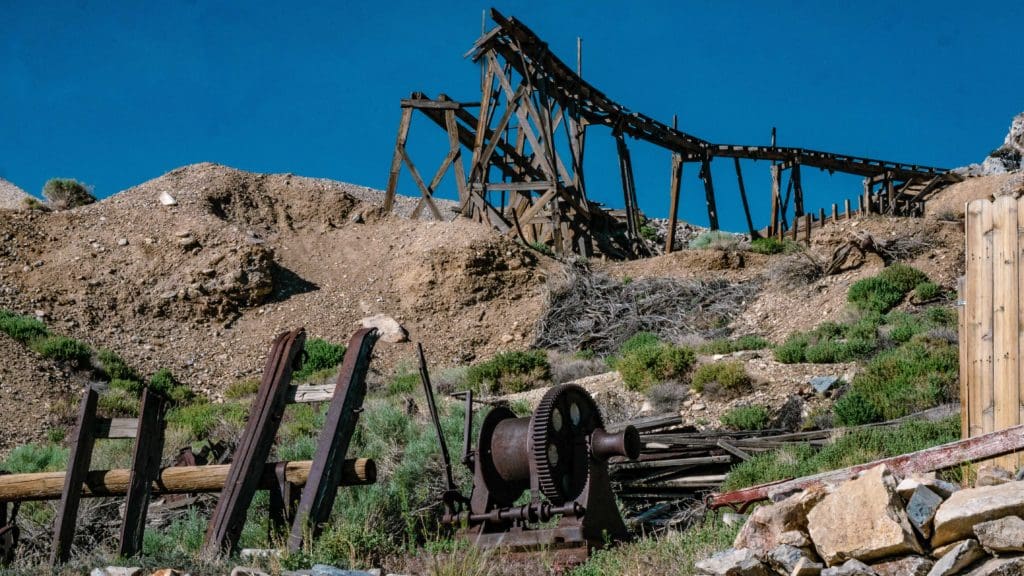
Old mine train track from the old ghost town, Cerro Gordo.
Chloride City: Entering the park on Highway 374, you’ll turn left between Daylight Pass and Hells Gate. You’ll get better and better views as you ascend into the Amargosa Mountains.
After 13 or so miles, you’ll come to Chloride City, the first area ever to be developed in the park. Today, there are a few standing buildings and closed-off mineshafts to see.
On the way out, you can come back the way you came or take the easier and quicker fork to the northeast.
A Living Landscape
Death Valley may be a punishing, harsh, barren landscape. But it’s also thriving. Everything in the Mojave Desert, from the stones, to the sand, to the thousands of species of wildlife, are growing and changing.
But you won’t notice if you don’t pay attention. It’s the kind of thing you have to get a taste for. Who knows? You may just get hooked on the magic of the desert.




